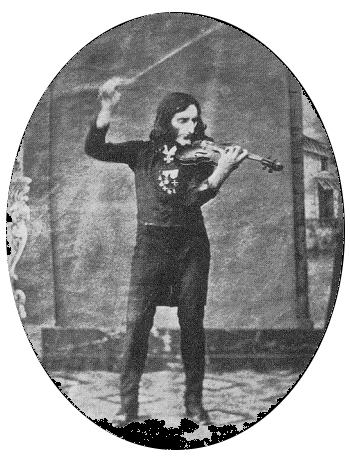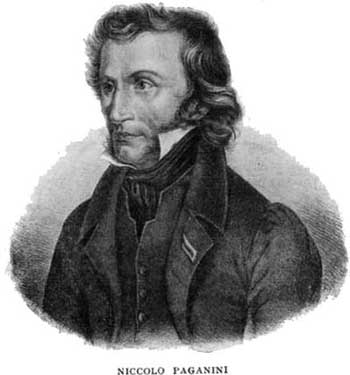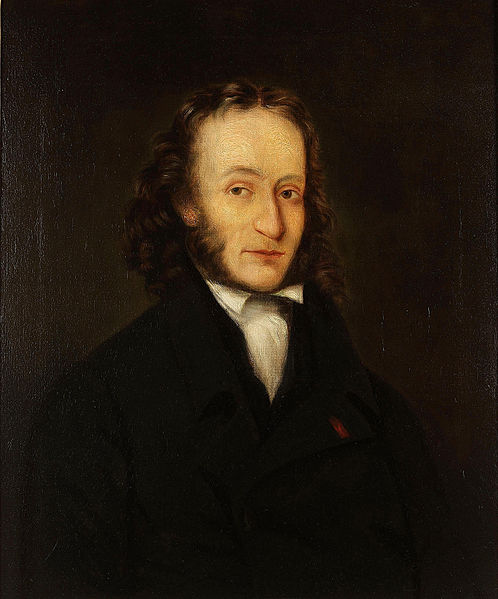<Back to Index>
- Violinist, Violist, Guitarist and Composer Niccolò Paganini, 1782
PAGE SPONSOR



Niccolò (or Nicolò) Paganini (27 October 1782 – 27 May 1840) was an Italian violinist, violist, guitarist and composer. He was one of the most celebrated violin virtuosi of his time, and left his mark as one of the pillars of modern violin technique. His Caprice No. 24 in A minor, Op. 1, is among the best known of his compositions, and has served as an inspiration for many prominent composers.
Niccolò Paganini was born in Genoa, Italy, the third of the six children of Antonio and Teresa (née Bocciardo) Paganini. Paganini's father was an unsuccessful trader, but he managed to supplement his income through playing music on the mandolin. At the age of five, Paganini started learning the mandolin from his father, and moved to the violin by the age of seven. His musical talents were quickly recognized, earning him numerous scholarships for violin lessons. The young Paganini studied under various local violinists, including Giovanni Servetto and Giacomo Costa, but his progress quickly outpaced their abilities. Paganini and his father then traveled to Parma to seek further guidance from Alessandro Rolla. But upon listening to Paganini's playing, Rolla immediately referred him to his own teacher, Ferdinando Paer and, later, Paer's own teacher, Gasparo Ghiretti. Though Paganini did not stay long with Paer or Ghiretti, the two had considerable influence on his composition style.
The French invaded northern Italy in March 1796, and Genoa was not spared. The Paganinis sought refuge in their country property in Romairone, near Bolzaneto. By 1800, Paganini and his father traveled to Livorno, where Paganini played in concerts and his father resumed his maritime work. In 1801, Paganini, aged 18 at the time, was appointed first violin of the Republic of Lucca, but a substantial portion of his income came from freelancing. His fame as a violinist was matched only by his reputation as a gambler and womanizer.
In 1805, Lucca was annexed by Napoleonic France, and the region was ceded to Napoleon's sister, Elisa Baciocchi. Paganini became a violinist for the Baciocchi court, while giving private lessons to her husband, Felice. In 1807, Baciocchi became the Grand Duchess of Tuscany and her court was transferred to Florence. Paganini was part of the entourage, but, towards the end of 1809, he left Baciocchi to resume his freelance career.
For the next few years, Paganini returned to touring in the areas surrounding Parma and Genoa. Though he was very popular with the local audience, he was still not very well known in Europe. His first break came from an 1813 concert which took place at La Scala in Milan. The concert was a great success, and as a result Paganini began to attract the attention of other prominent, albeit more conservative, musicians across Europe. His early encounters with Charles Philippe Lafont and Louis Spohr created intense rivalry. His concert activities, however, were still limited to Italy for the next few years.
His fame spread across Europe with a concert tour that started in Vienna in August, 1828, stopping in every major European city in Germany, Poland and Bohemia until February, 1831 in Strasbourg. This was followed by tours in Paris and Britain. His technical ability and his willingness to display it received much critical acclaim. In addition to his own compositions, theme and variations being the most popular, Paganini also performed modified versions of works (primarily concertos) written by his early contemporaries, such as Rodolphe Kreutzer and Giovanni Battista Viotti.
Throughout his life, Paganini was no stranger to chronic illnesses. Although no definite medical proof exists, he was reputed to have been affected by Marfan syndrome. In addition, his frequent concert schedule, as well as his extravagant lifestyle, took their toll on his health. He was diagnosed with syphilis as early as 1822, and his remedy, which included mercury and opium, came with serious health and psychological side effects. In 1834, while still in Paris, he was treated for tuberculosis. Though his recovery was reasonably quick, his future career was marred with frequent cancellations due to various health problems, from the common cold to depression, which lasted from days to months.
In September 1834, Paganini put an end to his concert career and returned to Genoa. Contrary to popular beliefs involving him wishing to keep his music and techniques secret, Paganini devoted his time to the publication of his compositions and violin methods. He accepted students, of whom two enjoyed moderate success: violinist Camillo Sivori and cellist Gaetano Ciandelli. Neither, however, considered Paganini helpful or inspirational. In 1835, Paganini returned to Parma, this time under the employ of Archduchess Marie Louise of Austria, Napoleon's second wife. He was in charge of reorganizing her court orchestra. Unfortunately, he eventually came to be at odds with the players and court, so his visions never saw completion.
In 1836, Paganini returned to Paris to set up a casino. Its immediate failure left him in financial ruins, and he auctioned off his personal effects, including his musical instruments, to recoup his losses. On Christmas of 1838, he left Paris for Marseilles and, after a brief stay, traveled to Nice where his condition worsened. In May 1840, the Bishop of Nice sent Paganini a local parish priest to perform the Last Rites. Paganini, assuming the sacrament to be premature, refused. A week later, on 27 May 1840, Paganini died from internal hemorrhaging before a priest could be summoned. On these grounds, and his widely rumored association with the devil, his body was denied a Catholic burial in Genoa. It took four years and an appeal to the Pope before the body was allowed to be transported to Genoa, but was still not buried. His remains were finally laid to rest in 1876 in a cemetery in Parma. In 1893, the Czech violinist, František Ondříček, persuaded Paganini's grandson, Attila, to allow a viewing of the violinist's body. After the bizarre episode, Paganini's body was finally reinterred in a new cemetery in Parma in 1896.
Though having no shortage of romantic conquests, Paganini was once seriously involved with a singer named Antonia Bianchi from Como, whom he met in Milan in 1813. The two gave concerts together throughout Italy. They had a son, Achilles Cyrus Alexander, born on 23 July 1825, in Palermo and baptized at San Bartolomeo's. Their union was never legalized and it ended around April 1828 in Vienna. Paganini brought Achilles on his European tours, and Achilles would later accompany his father until the latter's death. He was instrumental in dealing with his father's burial, years after his death.
Throughout his career, Paganini also became close friends with composers Gioachino Rossini and Hector Berlioz. Rossini and Paganini met in Bologna in the summer of 1818. In January 1821, on his return from Naples, Paganini met Rossini again in Rome, just in time to become the composer's substitute conductor for his opera Mathilde de Sharbran, upon the sudden death of the original conductor. The violinist's efforts earned gratitude from the composer.
Meanwhile, Paganini was introduced to Berlioz in Paris in 1833. Though Paganini also commissioned from him Harold en Italie for viola and orchestra, he never performed it, and instead it was premiered a year later by violist Christian Urhan. Despite his alleged lack of interest in Harold, Paganini often referred to Berlioz as the resurrection of Beethoven and, towards the end of his life, he gave large sums to the composer.
Paganini was in possession of a number of fine string instruments. More legendary than these were the circumstances under which he obtained (and lost) some of them. While Paganini was still a teenager in Livorno, a wealthy businessman named Livron lent him a violin, made by the master luthier Giuseppe Guarneri, for a concert. Livron was so impressed with Paganini's playing that he refused to take it back. This particular violin would come to be known as Il Cannone Guarnerius. On a later occasion in Parma, he won another valuable violin (also by Guarneri) after a difficult sight reading challenge brought on by a man named Pasini.
Other instruments associated with Paganini include the Antonio Amati 1600, the Nicolò Amati 1657, the Paganini - Desaint 1680 Stradivari, the Guarneri - filius Andrea 1706, the Le Brun 1712 Stradivari, the Vuillaume c. 1720 Bergonzi, the Hubay 1726 Stradivari, and the Comte Cozio di Salabue 1727 violins; the Countess of Flanders 1582 da Salò - di Bertolotti, and the Mendelssohn 1731 Stradivari violas; the Piatti 1700 Goffriller, the Stanlein 1707 Stradivari, and the Ladenburg 1736 Stradivari cellos; and the Grobert of Mirecourt 1820 (guitar). Four of these instruments are now played by the Tokyo String Quartet.
Paganini composed his own works to play exclusively in his concerts, all of which had profound influences on the evolution of violin techniques. His 24 Caprices were probably composed in the period between 1805 to 1809, while he was in the service of the Baciocchi court. Also during this period, he composed the majority of the solo pieces, duo - sonatas, trios and quartets for the guitar. These chamber works may have been inspired by the publication, in Lucca, of the guitar quintets of Boccherini. Many of his variations (and he has become the de facto master of this musical genre), including Le Streghe, The Carnival of Venice, and Nel cor più non mi sento, were composed, or at least first performed, before his European concert tour.
Generally speaking, Paganini's compositions were technically imaginative, and the timbre of the instrument was greatly expanded as a result of these works. Sounds of different musical instruments and animals were often imitated. One such composition was titled Il Fandango Spanolo (The Spanish Dance), which featured a series of humorous imitations of farm animals. Even more outrageous was a solo piece Duetto Amoroso, in which the sighs and groans of lovers were intimately depicted on the violin. Fortunately there survives a manuscript of the Duetto which has been recorded, while the existence of the Fandango is known only through concert posters.
However, his works were criticized for lacking characteristics of true polyphonism, as pointed out by Eugène Ysaÿe. Yehudi Menuhin, on the other hand, suggested that this might have been the result of his reliance on the guitar (in lieu of the piano) as an aid in composition. The orchestral parts for his concertos were often polite, unadventurous, and clearly supportive of the soloist. In this, his style is consistent with that of other Italian composers such as Paisiello, Rossini and Donizetti, who were influenced by the guitar song milieu of Naples during this period.
Paganini was also the inspiration of many prominent composers. Both "La Campanella" and the A minor caprice (Nr. 24) have been an object of interest for a number of composers. Franz Liszt, Robert Schumann, Johannes Brahms, Sergei Rachmaninoff, Boris Blacher, Andrew Lloyd Webber, George Rochberg and Witold Lutosławski, among others, wrote well known variations on these themes.
The Israeli violinist Ivry Gitlis once referred to Paganini as a phenomenon rather than a development. Though some of the techniques frequently employed by Paganini were already present, most accomplished violinists of the time focused on intonation and bowing techniques. Arcangelo Corelli (1653 – 1713) was considered a pioneer in transforming the violin from an ensemble instrument to a solo instrument. In the meantime, the polyphonic capability of the violin was firmly established through the Sonatas and Partitas BWV 1001 – 1006 of Johann Sebastian Bach (1685 – 1750). Other notable violinists included Antonio Vivaldi (1678 – 1741) and Giuseppe Tartini (1692 – 1770), who, in their compositions, reflected the increasing technical and musical demands on the violinist. Although the role of the violin in music drastically changed through this period, progress in violin technique was steady but slow. Techniques requiring agility of the fingers and the bow were still considered unorthodox and discouraged by the established community of violinists.
Much of Paganini's playing (and his violin composition) was influenced by two violinists, Pietro Locatelli (1693 – 1746) and August Duranowski (1770 – 1834). During Paganini's study in Parma, he came across the 24 Caprices of Locatelli (entitled L'arte di nuova modulazione – Capricci enigmatici or The art of the new style – the enigmatic caprices). Published in the 1730s, they were shunned by the musical authorities for their technical innovations, and were forgotten by the musical community at large. Around the same time, Durand, a former student of Giovanni Battista Viotti (1755 – 1824), became a celebrated violinist. He was renowned for his use of harmonics and the left hand pizzicato in his performance. Paganini was impressed by Durand's innovations and showmanship, which later also became the hallmarks of the young violin virtuoso. Paganini was instrumental in the revival and popularization of these violinistic techniques, which are now incorporated into regular compositions.
Another aspect of Paganini's violin techniques concerned his flexibility. He had exceptionally long fingers and was capable of playing three octaves across four strings in a hand span, an extraordinarily difficult feat even by today's standards. His seemingly unnatural ability may have been a result of Marfan syndrome.
The Caprice No. 24 in A minor, Op. 1, (Tema con variazioni) has been the basis of works by many other composers. The most notable examples include Brahms's Variations on a Theme of Paganini and Rachmaninoff's Rhapsody on a Theme of Paganini.
Notable works inspired by other compositions of Paganini include:
- Mike Campese – "Paganini", arrangement of Caprice No. 16 and various works.
- Alfredo Casella – Paganiniana, arrangement of four caprices
- Mario Castelnuovo - Tedesco – Capriccio Diabolico for classical guitar is a homage to Paganini, and quotes "La campanella"
- Frédéric Chopin – Souvenir de Paganini for solo piano (1829; published posthumously)
- Johann Nepomuk Hummel – Fantasia for piano in C major "Souvenir de Paganini", WoO 8, S. 190.
- Fritz Kreisler – Paganini Concerto in D major (recomposed paraphrase of the first movement of the Op. 6 Concerto) for violin and orchestra
- Franz Lehár – Paganini, a fictionalized operetta about Paganini (1925)
- Franz Liszt – Six Grandes Études de Paganini, S.141 for solo piano (1851) (virtuoso arrangements of 5 caprices, including the 24th, and La Campanella from Violin Concerto No. 2)
- George Rochberg – Caprice Variations (1970), 50 variations for solo violin
- Ulrich Roth – "Scherzo Alla Paganini" and "Paganini Paraphrase"
- Robert Schumann – Studies after Caprices by Paganini, Op. 3 (1832; piano); 6 Concert Studies on Caprices by Paganini, Op. 10 (1833, piano). A movement from his piano work Carnaval (Op. 9) is named for Paganini.
- Marilyn Shrude – Renewing the Myth for alto saxophone and piano
- Steve Vai – "Eugene's Trick Bag" from the movie Crossroads. Based on Caprice Nr. 5
- Philip Wilby – Paganini Variations, for both wind band and brass band
- Eugène Ysaÿe – Paganini variations for violin and piano
The Paganini Competition (Premio Paganini) is an international violin competition created in 1954 in his home city of Genoa and named in his honor.
In 1972 the State of Italy purchased a large collection of Niccolò Paganini manuscripts from the W. Heyer Library of Cologne. They are housed at the Biblioteca Casanatense in Rome.
In 1982 the city of Genoa commissioned a thematic catalog of music by Paganini, edited by Maria Rosa Moretti and Anna Sorrento, hence the abbreviation "MS" assigned to his cataloged works.
A minor planet 2859 Paganini discovered in 1978 by Soviet astronomer Nikolai Chernykh is named after him.
Paganini has been portrayed by a number of actors in film and television productions, including Stewart Granger in the 1946 biographical portrait The Magic Bow, Roxy Roth in A Song to Remember, and Klaus Kinski in Kinski Paganini (1989).
In the Soviet 1982 miniseries Niccolo Paganini the musician is portrayed by the Armenian actor Vladimir Msryan. The series focuses on Paganini's relationship with the Roman Catholic Church. Another Soviet actor, Armen Dzhigarkhanyan, plays Paganini's fictionalized arch rival, an insidious Jesuit official. The information in the series is generally spurious and it also plays to some of the myths and legends rampant during the musician's lifetime. One memorable scene shows Paganini's adversaries sabotaging his violin before a high profile performance, causing all strings but one to break during the concert. An undeterred Paganini continues to perform on three, two, and finally on a single string. In actuality, Paganini would, on occasion, intentionally break strings himself during a performance so he could further display his virtuosity. In 1827, Pope Leo XII honored Paganini with the Order of the Golden Spur.
In Don Nigro's satirical comedy Paganini (1995), the great violinist seeks vainly for his salvation, claiming that he unknowingly sold his soul to the Devil. "Variation upon variation," he cries at one point, "but which variation leads to salvation and which to damnation? Music is a question for which there is no answer." Paganini is portrayed as having killed three of his lovers and sinking repeatedly into poverty, prison and drink. Each time he is "rescued" by the Devil who appears in different guises, returning Paganini's violin so he can continue playing. In the end, Paganini's salvation — administered by a god - like Clockmaker — turns out to be imprisonment in a large bottle where he plays his music for the amusement of the public through all eternity. "Do not pity him, my dear," the Clockmaker tells Antonia, one of Paganini's murdered wives. "He is alone with the answer for which there is no question. The saved and the damned are the same."